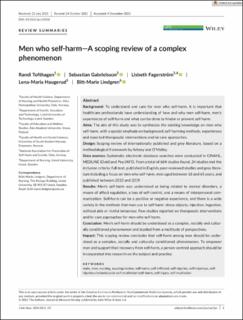| dc.contributor.author | Tofthagen, Randi | |
| dc.contributor.author | Gabrielsson, Sebastian | |
| dc.contributor.author | Fagerström, Lisbeth | |
| dc.contributor.author | Haugerud, Lena-Maria | |
| dc.contributor.author | Lindgren, Bitt-Marie | |
| dc.date.accessioned | 2022-10-19T07:51:23Z | |
| dc.date.available | 2022-10-19T07:51:23Z | |
| dc.date.created | 2022-02-01T10:38:24Z | |
| dc.date.issued | 2021 | |
| dc.identifier.citation | Tofthagen, R., Gabrielsson, S., Fagerström, L., Haugerud, L.-M. & Lindgren, B.-M. (2022). Men who self-harm—A scoping review of a complex phenomenon. Journal of Advanced Nursing, 78(5), 1187-1211. | en_US |
| dc.identifier.issn | 0309-2402 | |
| dc.identifier.uri | https://hdl.handle.net/11250/3026922 | |
| dc.description.abstract | Background: To understand and care for men who self-harm, it is important that healthcare professionals have understanding of how and why men self-harm, men's experiences of self-harm and what can be done to hinder or prevent self-harm.
Aims: The aim of this study was to synthesize the existing knowledge on men who self-harm, with a special emphasis on background, self-harming methods, experiences and reported therapeutic interventions and/or care approaches.
Design: Scoping review of internationally published and grey literature, based on a methodological framework by Arksey and O’Malley.
Data sources: Systematic electronic database searches were conducted in CINAHL, MEDLINE (Ovid) and PsycINFO. From a total of 684 studies found, 24 studies met the inclusion criteria: full-text, published in English, peer-reviewed studies and grey literature including a focus on men who self-harm, men aged between 18 and 65 years, and published between 2010 and 2019.
Results: Men's self-harm was understood as being related to mental disorders, a means of affect regulation, a loss of self-control, and a means of interpersonal communication. Self-harm can be a positive or negative experience, and there is a wide variety in the methods that men use to self-harm: sharp objects, injection, ingestion, without aids or riskful behaviour. Few studies reported on therapeutic interventions and/or care approaches for men who self-harm.
Conclusion: Men's self-harm should be understood as a complex, socially and culturally conditioned phenomenon and studied from a multitude of perspectives.
Impact: This scoping review concludes that self-harm among men should be understood as a complex, socially and culturally conditioned phenomenon. To empower men and support their recovery from self-harm, a person-centred approach should be incorporated into research on the subject and practice. | en_US |
| dc.language.iso | eng | en_US |
| dc.rights | Attribution-NonCommercial-NoDerivatives 4.0 Internasjonal | * |
| dc.rights.uri | http://creativecommons.org/licenses/by-nc-nd/4.0/deed.no | * |
| dc.title | Men who self-harm—A scoping review of a complex phenomenon | en_US |
| dc.title.alternative | Men who self harm - A scoping review of a complex phenomenon | en_US |
| dc.type | Journal article | en_US |
| dc.type | Peer reviewed | en_US |
| dc.description.version | publishedVersion | en_US |
| dc.rights.holder | © 2021 The Authors. | en_US |
| dc.source.pagenumber | 1187-1211 | en_US |
| dc.source.volume | 78 | en_US |
| dc.source.journal | Journal of Advanced Nursing | en_US |
| dc.source.issue | 5 | en_US |
| dc.identifier.doi | https://doi.org/10.1111/jan.15132 | |
| dc.identifier.cristin | 1996114 | |
| cristin.ispublished | true | |
| cristin.fulltext | original | |
| cristin.qualitycode | 2 | |

